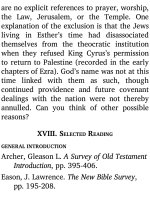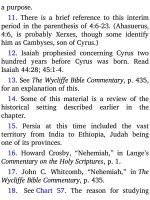Jensens survey of the old testament adam 604
Bạn đang xem bản rút gọn của tài liệu. Xem và tải ngay bản đầy đủ của tài liệu tại đây (117.26 KB, 4 trang )
statements of the epistle? How much is the
world in need of hearing these truths today?
IX. FURTHER STUDY OF 1 JOHN
1. Make a topical study of the word
fellowship (Greek koinonia) as it is used in
the New Testament. (It is interesting to note
that this word is mainly found in the Pauline
writings, 1 John being the exception.) Use
an exhaustive concordance to locate the
various places where the word is used.
Among the passages that you will want to
consult are: Acts 2:42; 1 Corinthians 1:9; 2
Corinthians 8:4; Philippians 1:5; 3:10.
2. Study the words sin, know, and the
phrase eternal life as these appear in the
Bible.
X. OUTLINE
1 JOHN: Fellowship with God and His
Children
JOHN’S GOSPEL AND FIRST EPISTLE
COMPARED
PERSONS OF THE FELLOWSHIP
1:1-4
LIGHT OF FELLOWSHIP
1:5—2:29
Conditions for Fellowship with God 1:5—2:2
Abiding in Christ
2:3-17
Antichrists and Christians
2:18-29
LOVE OF FELLOWSHIP
3:1—4:21
Beloved Sons of God
3:1-24
Truth and Love
4:1-21
WAY TO FELLOWSHIP
5:1-12
CERTAINTY OF FELLOWSHIP
5:13-21
XI. BACKGROUND OF 2 JOHN
One very valuable contribution of John’s
second and third epistles is their picture of
typical local churches. These churches were
existing a half century after Christ’s
ascension to heaven. Problems in churches
today are not unique to our age. Concerning
John’s third epistle, Charles Ryrie says, “This
brief and very personal letter shatters the
notion that the state of things was ideal, or
nearly so, in the rst century. Contrariwise,
it reveals the problems of a vigorously
growing faith.”12 When considering this,
one begins to see something of God’s
purpose in including such short letters as 2
and 3 John in His Holy Book.
A. AUTHOR
The writer identi es himself only as “the
elder.” Internal evidence and tradition point
to the apostle John as the author.
B. ADDRESSEES
The epistle was written to “the chosen
lady and her children.” This designation has
two possible interpretations.
1 . Figurative. By this the “chosen lady”
refers to a local church or the church as a
whole; and “her children” refers to members
of the church.
2 . Literal. By this “the chosen lady” is an
unnamed lady; or her name is Cyria (Greek
eklekta kuria, translated “elect Cyria”), or
Electa (translating the Greek as “the lady
Electa”). The lady was a Christian friend of
John, mother of children, well known in her
community, whose sister’s children were
probably residents of Ephesus.
The informal, personal style of the epistle
favors the literal view.
C. DATE AND PLACE WRITTEN
Written around
Ephesus.
A.D.
90 from the city of









